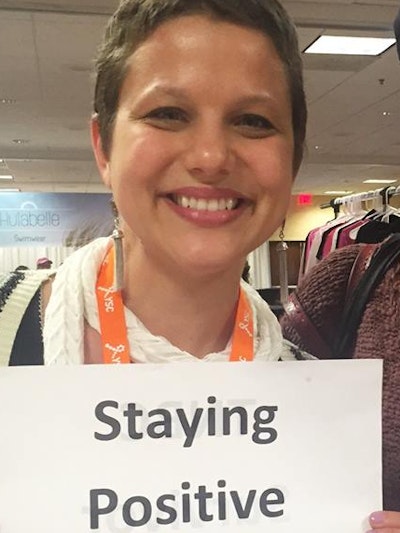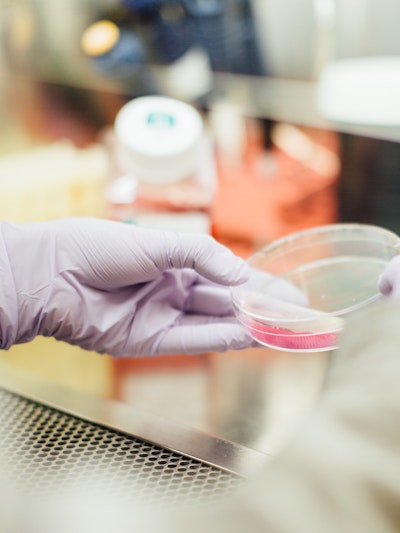Your Guide to the 2021 San Antonio Breast Cancer Symposium

Daily Updates from SABCS
Friday, December 10
On this final day of SABCS, we asked Dr. Melissa Davis, the Scientific Director of the International Center for the Study of Breast Cancer Subtypes at Weill-Cornell Medical College, what newly presented research findings have been the most interesting and exciting. According to Dr. Davis, new technology being developed in TNBC research and treatment took the stage at this year’s SABCS.
Trials like the NeoTRIPaPDL1 trial have begun to use imaging mass cytometry in order to better understand the spatial realities of TNBC tumors. Imaging mass cytometry looks at TNBC tumors on a single cell level across the real space of the tumor. In a slice of each participant’s tumor, the NeoTRIPaPDL1 team were able to not only identify biomarkers, but also identify their spatial distribution. You can think of biomarkers as molecular signposts—they tell researchers exactly what the tumor is made up of. For example, the estrogen (+ or -) in a breast cancer diagnosis is a biomarker that informs researchers about the specific molecular makeup of a tumor and informs which treatment to use.
“This is really exciting for me because it's not predicated on just a single biomarker,” explained Dr. Davis. “It’s not just about whether PD1 or PDL1 is present, but in combination with understanding all of the cell types that are present and which cells are expressing what biomarker—that’s one of the big findings.”
NeoTRIPaPDL1 was a big data project with a large set of patients. As is, imaging mass cytometry is an expensive, time consuming test that uses huge quantities of energy and also requires a team of specialized analysts. Given the promise of its findings, it’s now up to the scientists to figure out a way to make this type of test usable in medical clinics.
Dr. Lisa Carey MD, ScM—Deputy Director for Clinical Science UNC Chapel Hill and the Lineberger Comprehensive Cancer Center—gave a plenary lecture entitled “Triple Negative Breast Cancer - Pitfalls and Progress.” She reiterated that “it’s not just about how many immune cells you have in the tumor, but where they are.” Much like Dr. Davis, Dr. Carey noted that spatial approaches to immune cells are predictive to treatment and are an exciting research focus in TNBC.
She went on to discuss three particularly promising advances in metastatic TNBC research:
- The advent of “smart chemo” or Antibody Drug Conjugates (ADCs). Dr. Carey believes that ADCs are the wave of the future in TNBC treatment, as evidenced by the ASCENT trial. Fortunately, there are lots of ADCs currently in development, as presented at SABCS 2021.
- New tumor targeted agents, like those targeting the PI3K/AKT pathway. Tumor targeted agent trials have shown mixed results, so Dr. Carey thinks of them as more of a “work-in-progress.” It’s difficult because TNBC “reprograms” in response to a lot of targeted agents, meaning that it can evade targeted treatment in some cases.
- Targeting tumor microenvironments. Immune checkpoint inhibitors (ICI), like those tested in the IMpassion and Keynote355 trials, have shown real impact in treating metastatic TNBC through targeting the microenvironment of tumors.
While today may be the last day of SABCS, you can always reach out to the TNBC Foundation, TOUCH, The Black Breast Cancer Alliance, and the Cancer Fashionista Foundation with any questions about breast cancer clinical trials, research, or treatment!
Thursday, December 9
Day three of SABCS tackled biomarkers, epigenetics, molecular subtyping, and novel targets in the treatment TNBC.
Therapeutic targets have been identified for most subtypes of breast cancer, but specific targets have yet to be determined for TNBC. As a result, conventional chemotherapy has remained the standard treatment for TNBC. TNBC patients deserve more effective and precise treatment options. Research presented at SABCS 2021 has explored what types of targeted treatments may be most effective for TNBC, with a focus on subtyping based treatment and targeted therapy models. Researchers believe that this type of precision treatment will be the future of TNBC treatment.
As Dr. Zhi-Ming Shao, MD, PhD, noted in his “Genomic and transcriptomic landscape of TNBC” presentation, one-size fits all treatment doesn’t work for TNBC because of the heterogeneity (or diversity) of TNBC. Dr. Shao explained the four widely accepted subtypes of TNBC, as well as their theorized target treatments (in parentheses):
- Basal-like immune-suppressed (BLIS) characterized by enriched mutational HRD subtype and HRD mutation signatures determined based on high HRD scores (platinum-based regimen)
- Immunomodulatory (IM) characterized by elevated immune cell signaling and high prevalence of TILs (immune checkpoint inhibitors)
- Luminal androgen receptor (LAR) characterized by upregulation of androgen receptor signaling (endocrine therapy, ERBB2 pathway targeting treatment, and CDK4/6 inhibitor)
- Mesenchymal (MES) characterized by showing characteristics of breast cancer stem cells or CSCs (targeting CSCs, STAT3 inhibitor)
In addition to zooming in on the specifics of TNBC in order to better treat patients, researchers are also investigating residual disease and improved ways to predict and intervene in TNBC recurrence.
The cTRAK TN, PERSEVERE, and OXEL studies all honed in on circulating tumor DNA (ctDNA) as an indicator of TNBC recurrence. Retrospective studies have shown that patients who are ctDNA+ after their initial treatment have a significantly higher risk of early disease progression and future relapse. But, those same results have not been shown in current patients followed in real-time. More research is needed to confirm the relationship between ctDNA and TNBC relapse as well as answer the key question: does early detection of relapse improve patient outcomes?
Wednesday, December 8
Day two of SABCS 2021 began with a spotlight poster session entitled “Targets in Triple Negative Breast Cancer.” TNBC is a collection of biologically diverse cancers with at least four known subtypes, each of which present their own specific mutations and gene expressions. The “Targets in TNBC” poster session explored early research that will lead to increased precision medicine when it comes to the treatment of TNBC. For example, today’s session focused on particular pathways in cancer cell development and progression that, when inhibited or turned off, may lead to more effective treatment of the specific subtypes of TNBC.
A few of those early results using inhibitors included:
- EZH2 inhibition + p38 (early results show that inhibiting this enzyme and pathway could slow breast cancer progression and metastases in patients with mesenchymal TNBC)
- Bromodomain inhibition + ULK complex inhibition (research suggests that this combination leads to enhanced anti-tumor activity for TNBC)
- Inducible nitric oxide synthase (iNOS) inhibition + P13K axis inhibition (together, inhibition of this enzyme and pathway may be an effective therapeutic strategy in chemotherapy-resistant TNBC, ultimately suppressing tumor growth)
- Simultaneous inhibition of multiple cancer cell pathways (this approach may enhance a TNBC tumor’s response to chemotherapy)
Further studies are needed across the board in order to confirm the results of these preclinical research studies. The closer we can get to understanding the specific science behind each unique subtype of TNBC, the better and more precise our treatments are going to become!
Another treatment trial that received attention today was phase 1 TROPION-PanTumor01 trial (NCT03401385) that explored datopotamab deruxtecan for patients with advanced or metastatic TNBC. Promising early data showed that treatment with datopotamab deruxtecan led to better overall response rates (ORRs)—the proportion of trial participants who respond to the therapy.
Finally, the educational session “Triple Negative Breast Cancer: Critical Update on Biology and Management” ran into technical difficulties for the virtual audience this evening, so keep an eye out for key updates from this session in tomorrow’s post!
Tuesday, December 7
The first day of SABCS opened with sessions on COVID-19, artificial intelligence, and clinical research. Of particular note were several trials that explored pembrolizumab (brand name Keytruda) as a treatment for TNBC.
Keynote 522 & 355 both investigated Keytruda in combination with an intense chemotherapy regimen for early stage TNBC patients. They found that compared to participants not on Keytruda, patients on Keytruda had better pCR (disappearance of all invasive cancer in the breast after completion of neoadjuvant chemotherapy) and better event-free survival (survival without complications, recurrences, or debilitating symptoms).
Moreover, the research teams found that Keytruda with chemotherapy led to longer survival (both general survival and survival without progression of cancer) in patients with locally recurrent, inoperable or metastatic TNBC with a PD-L1 CPS cutoff score of 10 or higher. CPS scores are determined by the number of PD-L1 cells compared to the total number of tumor cells.
In addition, SABCS presented a special session entitled “Trust in Science and Healthcare.” The keynote speaker—Dr. Lori Wilson, a surgeon, researcher, educator, advocate, and metastatic breast cancer survivor/thriver who is the Division Chief of Surgical Oncology and Program Director of the General Surgery Residency at Howard University Hospital—focused on the need for a social contract of trust between patients, healthcare providers, and researchers in order to advance treatments for Black breast cancer patients.
According to Dr. Deborah Stroman, PhD, Black breast cancer patients are less likely to receive standard of care, are more likely to be told their diagnosis over the phone, and are less likely to receive a biopsy within 48 hours.
But in addition to these external disparities, current medical treatments are not working as well for Black women as they could, and should, be. Clinical trial participation among Black women is less than 3%, which means that new drugs aren’t approved based on how well they work in Black women’s bodies. When we consider TNBC—a subtype that impacts Black women at three times the rate of white women—we need treatments that are targeted for and better represent patient demographics.
The panel also noted the fact that most Black breast cancer patients aren’t told about clinical trial opportunities, so it’s important for Black women to speak up and ask their HCPs about clinical trials.
And as Dr. Olufunmilayo Olopade, MD said in her own SABCS keynote address, “It takes a village, it takes us coming together in solidarity.”




